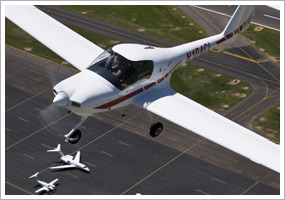training tips  Practical pattern politics Practical pattern politics If you were one of the lucky student pilots who logged your early lessons during the unpredictable winter months, quite a surprise may await as spring gets its footing and your airport comes alive. Gaps appear in the tiedown rows of seemingly orphaned aircraft. New faces appear in the FBO, and new, unfamiliar N numbers are heard joining the flow. Speaking of the flow, this abrupt change in your airport’s character will put you to the test. Flying leisurely traffic patterns as you did on those quiet winter days may not be an option. It may be necessary to extend pattern legs—or, a better idea, to slow down earlier—to maintain spacing behind another aircraft. Avoid any radical maneuvers. If there’s traffic to follow you, get down and off promptly—but never allow yourself to be rushed by an impatient voice in your headset (or your own!). Standardization is the goal (see the July 14, 2006, Training Tip), but in the real world pilots perform differently, as the vigorously debated January 2011 AOPA Pilot article “Dogfight: Pattern Entry” dramatized. Be ready for unexpected styles of approaches and departures. Use your landing light, even in daylight, not to see but to be seen. (A preflight review of the Air Safety Institute’s Nontowered Airport Operations Safety Advisor will be helpful, too.) Increased traffic means increased traffic variety, from hot air balloons to gliders and helicopters, as aviation blossoms in all its manifestations. It’s time to review the right-of-way rules in FAR 91.113. And because the simple answer isn’t always the right one, read more, starting with this November 2008 Flight Training article. One of the gaps in the flight line is the spot where a no-radio taildragger was holding up its share of snow. The pile of snow is still there, but where’s the Waco? In the pattern, possibly. Remember, it’s still see-and-avoid out there. Occasionally someone does something so objectionable that it’s tempting to not let yourself get elbowed out of the way. Don’t give in to temptation to be “dead right.” If the need is strong to discuss matters later with the impolitic pilot, start with a handshake and a cup of coffee. Chances are you’ll make your point—and a friend—while learning something and making your airport a safer and friendlier place. training products Zuluboard Mini Economy kneeboard Zuluworks, creator of the Zuluboard kneeboard, has released a smaller version that measures just 5.5 inches by 7.5 inches by 1.5 inches when closed. It is constructed of the same material as the traditional Zuluboard, but comes only with a blank pad. The Mini Economy sells for $24.99 and may be ordered from Pilotmall.com. Note: Products listed have not been evaluated by ePilot editors unless otherwise noted. AOPA assumes no responsibility for products or services listed or for claims or actions by manufacturers or vendors. final exam Question: What does LAHSO mean and can a student pilot accept one? Answer: LAHSO (Land and Hold Short Operations) is a procedure that requires a pilot who is landing to hold short of an intersecting runway, an intersecting taxiway, or some other designated point on the runway. Air traffic control sometimes implements these operations when increased capacity is necessary to maintain efficient movement of traffic. Pilots who accept a LAHSO clearance should be absolutely sure that they can comply with the operation. If there is any uncertainty, the pilot should decline the clearance by simply stating “unable” to the tower. A student pilot, while soloing, should never accept a LAHSO clearance. Check out the Aeronautical Information Manual (AIM) Chapter 4-3-11 for the most current information on LAHSO; and to test your knowledge take the Air Safety Institute quiz. Got a question for our technical services staff? E-mail [email protected] or call the Pilot Information Center, 800/872-2672. Don’t forget the online archive of “Final Exam” questions and answers, searchable by keyword or topic. |  Practical pattern politics
Practical pattern politics

